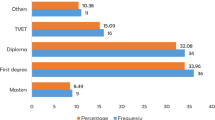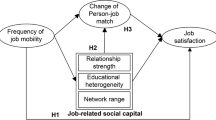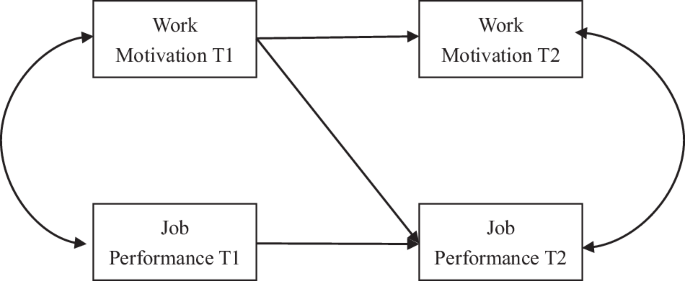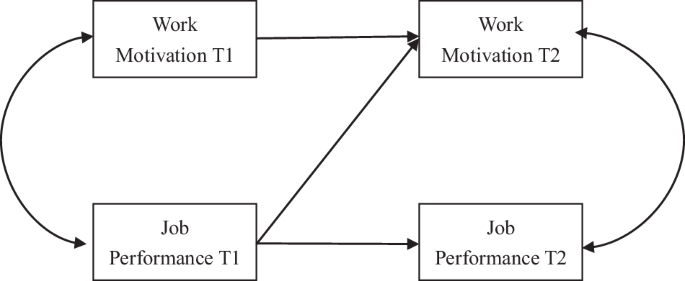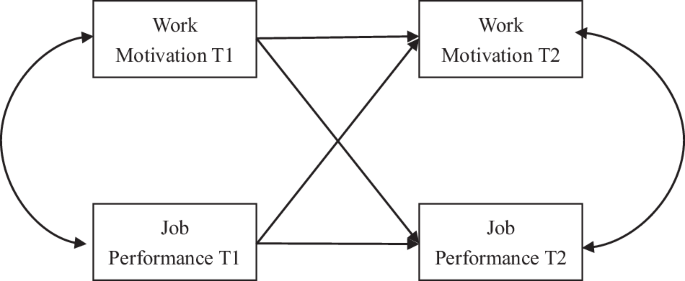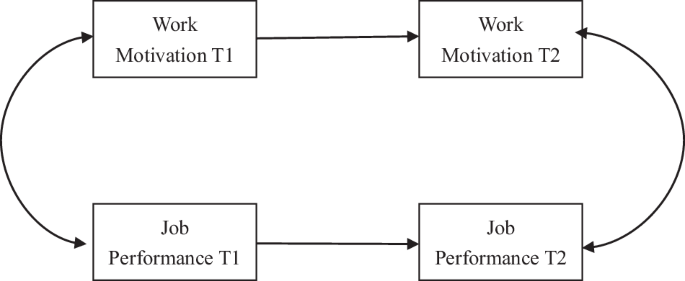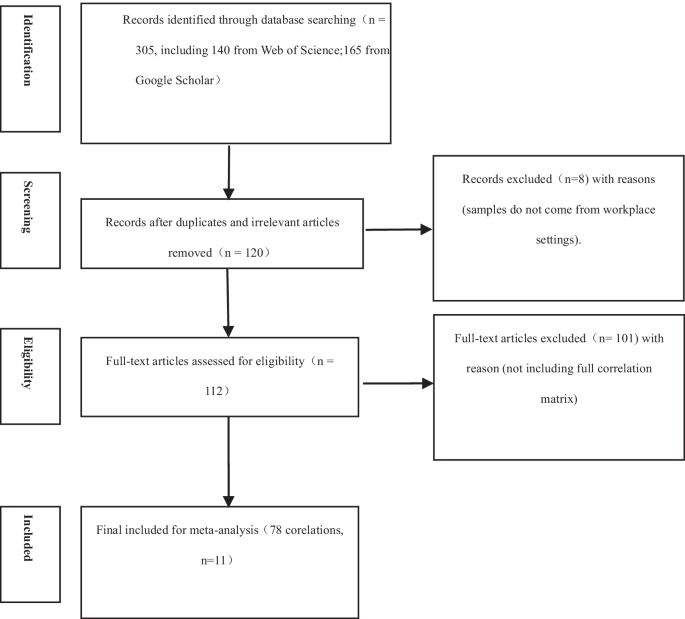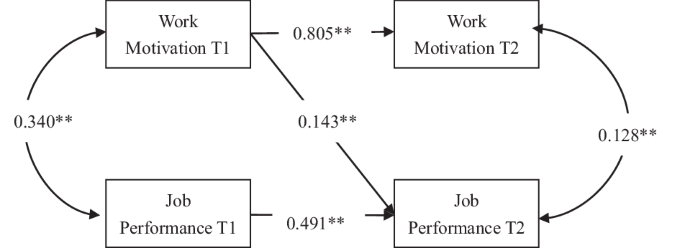Abstract
Given that competing hypotheses about the causal relationship between work motivation and job performance exist, the current research utilized meta-analytic structural equation modeling (MASEM) methodology to detect the causal relationships between work motivation and job performance. In particular, completing hypotheses were checked by applying longitudinal data that include 84 correlations (n = 4389) from 11 independent studies measuring both work motivation and job performance over two waves. We find that the effect of motivation (T1) on performance (T2), with performance (T1) controlled, was positive and significant (β = 0.143). However, the effect of performance (T1) on motivation (T2), with motivation (T1) controlled, was not significant. These findings remain stable and robust across different measures of job performance (task performance versus organizational citizenship behavior), different measures of work motivation (engagement versus other motivations), and different time lags (1–6 months versus 7–12 months), suggesting that work motivation is more likely to cause job performance than vice versa. Practical and theoretical contributions are discussed.
Similar content being viewed by others
Introduction
Job performance is defined as “scalable actions, behavior, and outcomes that employees engage in or bring about that are linked with and contribute to organizational goals” (Viswesvaran and Ones, 2000, p. 216), is a core concept in the applied psychological field (Campbell and Wiernik, 2015; Choi et al., 2022; Giancaspro et al., 2022; Hermanto and Srimulyani, 2022; Motowidlo, 2003). Employees’ job performance is important for both organization and the employee. For an organization, job performance is the vital antecedent of organizational performance (Almatrooshi et al., 2016); for an employee, job performance is a predictor of turnover (Bycio et al., 1990; Martin et al., 1981), and wellbeing (Bakker and Oerlemans, 2011; Ford et al., 2011). Considering the importance of job performance in the applied psychological field, it is not surprising that researchers have devoted significant effort to researching job performance, especially its antecedents.
Prior meta-analyses identified a series of antecedents of job performance, such as job satisfaction (Iaffaldano and Muchinsky, 1985; Judge et al., 2001; LePine et al., 2002), organizational commitment (Jaramillo et al., 2005; Mathieu and Zajac, 1990), and work motivation (Cerasoli et al., 2014; Van den Broeck et al., 2021; Van Iddekinge et al., 2018). Among these factors, motivation, which refers to the force that drives the direction, intensity, and persistence of employee behavior (Pinder, 2014), is a medium to strong predictor of performance (Cerasoli et al. 2014). Although the early meta-analyses (e.g., Cerasoli et al., 2014; Van Iddekinge et al., 2018) confirmed the significant correlations between work motivation and job performance, the accurate causal relationship between work motivation and job performance remains unclear. Does work motivation cause job performance? Does reverse causality exist? Or there is a reciprocal relationship between them? Unfortunately, previous meta-analyses (e.g., Cerasoli et al., 2014; Van Iddekinge et al., 2018), which are based on cross-temporal data rather than longitudinal cross-lagged panel data, could not address this research gap.
We propose four competing hypotheses to explain the causal relationship between them. First, work motivation causes job performance. Second, job performance causes work motivation. Third, work motivation causes job performance and vice versa (reciprocal model). Finally, work motivation and job performance are causally unrelated. In the Theory and Hypotheses part, we will describe these hypotheses in detail.
By checking all four hypotheses, the current study aims to reveal the causal relationship between work motivation and job performance. A single primary study could not accomplish our research goal due to the distorting of statistical artifacts (e.g., sampling error and measurement error; Hunter and Schmidt, 2004). For instance, the relationships of interest may vary when sampling from different organizations because of sampling error, which would harm the accuracy of the results. Fortunately, the meta-analysis methodology could help us to correct the statistical artifacts and thereby provide solid and reliable empirical evidence for the theory. As such, we utilize a meta-analysis methodology that allows us to aggregate cross-lagged panel data to test the four hypotheses.
This article provides the first meta-analysis that estimates the longitudinal effects between work motivation and job performance, contributing to both theory and practice. In terms of theory, this study will provide solid evidence for the causal relationship between work motivation and job performance, contributing to motivation and performance literature. In relation to practice, the results of our study will provide guidance for human resource management. For instance, if we find that motivation causes performance, using human resource practice (e.g., performance appraisal and training) that will influence motivation to improve performance will be reasonable; whereas if other results were found, perhaps we will reconsider the effectiveness of the current human resource practices.
Theory and hypotheses
In this part, we will review work motivation and job performance and their measurements. Then, we will develop the hypotheses between them. Finally, as a meta-analysis, we will propose a research question about the moderators that might influence the relationships between motivation and performance.
Before the 1970s, organizational psychologists primarily directed their attention toward job satisfaction, often sidelining the exploration of work performance (Organ, 2018). However, the tide turned in the 1980s, when scholars began conceptualizing individual job performance as a distinct construct (Campbell and Wiernik, 2015). Job performance is commonly characterized by two key forms: task performance and organizational citizenship behavior (OCB), providing a structured framework for evaluating employee contributions (Hoffman et al., 2007; Sidorenkov and Borokhovski, 2021; Young et al., 2021). Notably, performance should not be conflated with efficiency and productivity. While performance encompasses a broader term, often associated with achieving various levels or outcomes potentially under myriad conditions, both efficiency and productivity are intricately tied to the concept of optimizing resource utilization and maximizing output production (Campbell and Wiernik, 2015).
Task performance refers to the effectiveness with which job incumbents perform activities that contribute to the organization’s technical core (Borman and Motowidlo, 1997, p. 99). Notably, this concept is also identified as “in-role performance/behavior” in the literature (Koopmans et al., 2011; Raja and Johns, 2010). In-role performance essentially encapsulates behaviors aimed at fulfilling formal tasks, duties, and responsibilities, often detailed in job descriptions (Becker and Kernan, 2003; Williams and Anderson, 1991). Contrarily, early meta-analyses have amalgamated related concepts, acknowledging their overlapping domains (Riketta, 2008; Young et al., 2021). OCB is delineated as “individual behavior that is discretionary, not directly or explicitly recognized by the formal reward system, and that in the aggregate promotes the effective functioning of the organization” (Organ, 1988, p. 4). Contextual performance, reflecting actions extending beyond formal job descriptions and enhancing organizational effectiveness (MacKenzie et al., 1991), is frequently paralleled with OCB in meta-analytic practices (Riketta, 2008; Young et al., 2021). A noteworthy correlation between task performance and OCB (ρ = 0.74) is illuminated through a meta-analysis by Hoffman et al. (2007). While some scholars propose that performance can exhibit counterproductive facets (Campbell and Wiernik, 2015), meta-analysis unveils only a moderate relationship between OCB and counterproductive work behavior and reveals somewhat disparate relationship patterns with their antecedents (Dalal, 2005). Therefore, in this study, we study two fundamental dimensions of job performance: task performance and OCB.
Motivation reflects why people do something. It is widely researched in the work and educational psychological field (Anesukanjanakul et al., 2019; Christenson et al., 2012; Fishbach and Woolley, 2022; Hartinah et al., 2020; Muawanah et al., 2020). Work motivation stands distinct amidst a spectrum of related concepts. Firstly, it is imperative to differentiate motivation from personality. Personality, defined as a construct embodying a set of “traits and styles displayed by an individual, represents (a) dispositions, that is, natural tendencies or personal inclinations of the person, and (b) aspects wherein the individual deviates from the ‘standard normal person’ in their society” (Bergner, 2020, p.4). Personality acts as a distal antecedent to performance, influencing it indirectly through the medium of motivation (Judge and Ilies, 2002; Kanfer et al., 2017). Secondly, while interrelated, goal pursuit and motivation are distinctive concepts. For example, if employees aim to earn money, their motivations are characterized as external. Conversely, intrinsically motivated employees engage in work for the enjoyment derived from the process itself, potentially without being driven by explicit work goals (Deci et al., 2017). Thirdly, motivation is different from attitude. Job attitudes (e.g., job satisfaction) reflect the evaluations of one’s job (Judge and Kammeyer-Mueller, 2012). Motivation may not necessarily include the evaluation of the job. For instance, engaged people, who usually put a great deal of effort into their work (Bakker et al., 2014), may not include the evaluation of the job. Actually, attitudes may likely be influenced by motivations, indicating they are different concepts (Judge and Kammeyer-Mueller, 2012).
As work motivation is a very grand concept, many psychological and organizational theories try to measure motivation by using different scales. For instance, in the perspective of the Job Demands–Resources (JD-R) Theory (Bakker, 2011; Bakker and Demerouti, 2017), work engagement is regarded as the motivation factor that links job resources and job performance; in the perspective of the Self-determination Theory (SDT), motivation (e.g., intrinsic motivation and extrinsic motivation) is the antecedent of job performance (Deci et al., 2017; Deci and Ryan, 2000). In the review process, we notice that work engagement is one of the most widely-used measurements of motivation when researching the work motivation-job performance linkage.
Hypotheses between motivation and performance
The first potential causal relationship is that work motivation causes job performance. This argument is shown in Fig. 1. This Argument is supported by many well-established theories and empirical evidence. To start, in the JD-R theory (Bakker, 2011; Bakker and Demerouti, 2007; Bakker and Demerouti, 2017), engaged (well-motivated) people will accomplish job performance because they will experience more positive emotions which may increase the creation of new ideas and resources and they will be healthy and be energetic at work. The correlational relationship was confirmed by a prior meta-analysis as it found a medium correlation (ρ = 0.48) between engagement and job performance (Neuber et al., 2021). Then, from the perspective of SDT (Deci et al., 2017; Deci and Ryan, 2000; Gagné and Deci, 2005), motivation also influences performance. In particular, intrinsically motivated employees will be creative and productive, increasing their job performance. An early meta-analysis finds a moderate correlation between intrinsic motivation and performance (ρ = 0.28) (Cerasoli et al., 2014). Finally, motivation may influence performance directly by determining the level of effort and persistence an individual will exert in the face of obstacles (Kanfer, 1990). Motivation may also influence performance indirectly, as motivated individuals are more likely to set challenging goals and commit to achieving them, leading to higher performance (Locke and Latham, 2006). Together, it seems obvious that work motivation will cause subsequent job performance. When using the cross-lagged panel research design to test this hypothesis, the subsequent performance will be predicted by the previous motivation after controlling the auto-correlation effect. As such, the following hypothesis is proposed:
Hypothesis 1: Work motivation causes job performance. In particular, work motivation (T1) is the significant predictor of job performance (T2) after controlling the auto-correlation effect of job performance (T1).
As illustrated in Fig. 2, the second potential causal relationship is that performance causes motivation. As SDT suggested, feedback will influence motivation (Deci et al., 1999). Employees who achieve job performance may receive positive feedback (e.g., pay and recognition) from their organizations and leaders (Riketta, 2008), increasing their work motivation. Applying longitudinal data, Presbitero (2017) provided indirect evidence that improvements in reward management yielded a positive change in the level of motivation (measured by engagement). Therefore, we hypothesize the following:
Hypothesis 2: Job performance causes work motivation. In particular, job performance (T1) is the significant predictor of work motivation (T2) after controlling the auto-correlation effect of work motivation (T1).
According to Fig. 3, the third hypothesis is that motivation causes performance and performance causes motivation simultaneously. Combining Hypotheses 1 and 2, we could conclude this reciprocal hypothesis. Utilizing cross-lagged panel data, early studies found reciprocal relationships between (a) self-efficacy and academic performance (Talsma et al., 2018) and (b) job characteristics and emotional exhaustion (Konze et al., 2017). That is to say, there might be a reciprocal relationship between variables. Thus, we derive the following hypotheses:
Hypothesis 3: There is a reciprocal causal relationship between work motivation and job performance. In particular, work motivation (T1) is the significant predictor of job performance (T2) after controlling the auto-correlation effect of job performance (T1) and vice versa.
As presented in Fig. 4, the final potential causal relationship is that performance and motivation are causally unrelated. Performance and motivation may be causally unrelated due to cross-temporal research design and common method bias (Podsakoff et al., 2003). For instance, when work motivation and job performance are measured at the same time point and rated by one person, their correlation may inflate due to common method bias and thereby draw inaccurate causality. Therefore, we put the following hypothesis:
Hypothesis 4: Work motivation and job performance are causally unrelated. In particular, work motivation (T1) is not a significant predictor of job performance (T2) after controlling the auto-correlation effect of job performance (T1), whereas job performance (T1) is also not the significant predictor of work motivation (T2) after controlling the auto-correlation effect of work motivation (T1).
We also propose a research question about the potential moderators that may influence the relationship of interest. Following early longitudinal meta-analyses (Riketta, 2008; Talsma et al., 2018), three moderators are considered, namely, performance measurements, motivation measurements, and length of time lag (shorter vs. longer time lags between two waves).
Firstly, as we illustrated in the Introduction part, there are two measurements of work performance, namely, task performance and OCB. We would like to explore the potential moderating role of job performance measurements (task performance versus OCB). This exploration is pivotal. Theoretically, performance should envelop two dimensions: task performance and OCB (Koopmans et al., 2011). However, a disparity exists in organizational recognition and reward systems, wherein task performance is formally acknowledged, while OCB is not (Organ, 2018). The impact of such discrepancies on their respective relationships with performance remains nebulous. Undertaking a meta-analysis to probe into these moderating variables will not only deepen our understanding of the nexus between motivation and performance but also furnish supplementary evidence to buttress their interconnection.
Secondly, the motivation measurement is taken into consideration. In particular, many longitudinal studies (e.g., Shimazu et al., 2018; Nawrocka et al., 2021) use work engagement to measure motivation. Although theoretical frameworks suggest that these measures might reflect motivation, various measures of motivation may exhibit distinct relationships with performance. Despite the absence of cross-lagged meta-analyses, insights can potentially be derived from cross-temporal meta-analyses. For example, Cerasoli et al. (2014) identified a correlation of 0.26 between intrinsic motivation and performance, while Corbeanu and Iliescu (2023) observed a correlation of 0.37 between work engagement and performance. Consequently, we question whether the measurement of motivation exerts a significant moderating effect. Given that work engagement is the most prevalently utilized measure, we draw comparisons between the results pertaining to work engagement and those associated with other forms of motivation.
Finally, it is unclear how long the time lag process (i.e., the length of time between two measurement waves) will influence the relationship of interest. In the present study, time lags varied from 1 to 12 months (refer to the coding information for details). On the one hand, the relationship between motivation and performance may depend on time. For instance, even with strong motivation, employees may require time to learn and adapt to new tasks, affecting performance enhancement. Furthermore, the delay in receiving feedback or recognition, especially in long-term projects, may decelerate the positive influence of performance on motivation.
On the other hand, there may exist an optimal time lag interval in cross-lagged analysis, as suggested by Dormann and Griffin (2015). When the time lag falls short of this optimal point, the cross-lagged effect size diminishes sharply; inversely, if the time lag exceeds it, the effect size likewise declines. Aligning with prior meta-analysis efforts (Riketta, 2008), we categorize the time lag into two groups, namely, 1–6 months and 7–12 months, to explore the possible moderating influence of the time lag. The efficacy of a 6-month time lag design remains uncertain. Nevertheless, a design that maintains a 6-month interval at each end—presenting a symmetrical six-month span—prompts a subgroup analysis within the meta-analysis, increasing the likelihood of discerning potential moderating impacts. To sum up, we seek to answer the following research question:
Research Question 1: Do the causal relationship between work motivation and job performance vary due to (a) job performance measurement (task performance versus OCB), (b) work motivation measurement (work commitment versus other motivations), and (c) time lag (1–6 months versus 7–12 months)?
Method
Literature search
To locate the studies that might include the cross-lagged data about work motivation and job performance, following early meta-analyses (Neuber et al., 2021; Riketta, 2008; Van Iddekinge et al., 2018), the authors searched the following keywords: (a) motivation (motivation or engagement), (b) performance (performance, job performance, task performance, or organization citizenship behavior), and (c) cross-lagged (longitudinal or cross-lagged) utilizing Web of Science and Google Scholar databases. The authors (W and L) seek to include studies published from 2000 to 2022. The search was conducted in January 2023 and encompassed English-language research materials. We did not restrict the types of research sources, including journal articles, book chapters, and dissertations. Authors W and L performed the search using the Title, Abstract, and Keywords. After removing duplicates, the authors initially obtained 120 potential articles that used longitudinal data.
Inclusion criteria and coding
After reviewing some early published longitudinal meta-analyses (Maricuțoiu et al., 2017; Riketta, 2008; Talsma et al., 2018), the authors made the following inclusion criteria. First, samples should come from organizations because the current study focuses on work motivation and job performance. As such, students’ or athletes’ samples were removed.
Second, studies should provide a full correlation matrix that includes six correlations and measure motivation and performance at two (or more) measurement waves. Six correlations are two synchronous correlations, the two cross-lagged correlations, and the two stabilities correlations (Kenny, 1975). In particular, two synchronous correlations are correlations (a) between motivation (T1) and performance (T1) and (b) between motivation (T2) and performance (T2). Two cross-lagged correlations are correlations (a) between motivation (T1) and performance (T2) and (b) between performance (T1) and motivation (T2). Two stabilities correlations are correlations (a) between motivation (T1) and motivation (T2) and (b) between performance (T1) and performance (T2).
After reading all potential studies (k = 120) and excluding studies that were not able to meet the inclusion criteria, the final database contained 11 studies that included 84 correlations (n = 4389). Considering the challenges in obtaining samples and findings from early meta-analyses (Riketta, 2008, with 16 studies; Talsma et al., 2018, with 11 studies), a sample of 11 studies is likely sufficient for conducting a cross-lagged meta-analysis. Two authors coded the following information: bibliographic references (authors and publication year), sample description (sample size and country), research design (interval between two measurement waves), effect sizes, and the reliabilities (i.e., Cronbach’s α) of all scales. The authors discussed the differences in the coding information until the intercoder agreement was researched 100%. Among the examined studies, 8 utilized a self-reported method for measuring performance, 2 adopted a leader-reported method, and 1 study employed an objective indicator, specifically the results of performance appraisals. The majority of these studies (k = 10) originated from companies, with only one emanating from an educational organization. The samples in the 11 studies encompass a wide range of industries, including banking, auditing, and social services. The diversity in this study stems from the primary authors’ intentional strategy to collect data from a variety of industries. This approach enables a comprehensive insight into the nature of professional settings and employee motivation across different sectors. Geographically, most samples were drawn from Europe (k = 9), while the remaining were from East Asia (k = 2). A PRISMA flowchart (see Fig. 5) presents the process of literature search.
Analysis
Before analyzing, publication bias is taken into consideration. We used the Trim-and-Fill method and Eggs’ Regression method to detect potential publication bias. This analysis was conducted utilizing metafor package (Viechtbauer, 2010) in R. The results were shown in Table 1.
Generally speaking, there are two steps in a meta-analytic structural equation modeling analysis (Bergh et al., 2016; Viswesvaran and Ones, 1995). The first one is to build a meta-analytic correlation matrix. The second one is to use this matrix to conduct path analysis. In the current study, to build a meta-analytic correlation matrix, we employed the Hunter-Schmidt methods’ meta-analysis technology to aggregate effect sizes (Hunter and Schmidt, 2004). In particular, reliabilities (i.e., Cronbach’s α) were used to correct measurement errors. The random effect meta-analysis method was utilized to correct sampling errors. This analysis was accomplished using the psychmeta package (Dahlke and Wiernik, 2019) in R. The results of the meta-analytic correlation matrix for path analysis were shown in Table 2. To answer research question 1, Table 2 also includes correlations that are grouped by performance measurements, motivation measurements, and time lags.
Then, this meta-analytic correlation matrix was used to conduct path analysis, the results were shown in Table 3. This analysis was accomplished using MPLUS software (Muthén and Muthén, 2017). Specifically, to conduct path analysis, the maximum likelihood estimation (MLE) was used. Besides, the sum of the sample sizes was employed as the inputted sample size (Riketta, 2008).
Results
As Table 1 shows, the results suggest there is not a significant publication bias. First, using the Trim-and-Fill method, only one asymmetric effect size was located (i.e., the correlation between performance T1 and performance T2). After inputting this “missed” correlation, the averaged correlation only decreased by 0.02, suggesting the publication bias is not serious. Second, utilizing the Eggs’ Regression method, all the p-values are bigger than 0.05, confirming the publication bias is not significant. Together, the overall publication bias is not serious.
Table 2 depicts the averaged correlation (r) and true score correlation (ρ) of interest. For instance, the ρ between motivation (T1) and motivation (T2) is 0.80, whereas the ρ between performance (T1) and performance (T2) is 0.54.
As Table 3 presents, overall, work motivation appears to be a predictor of job performance, whereas job performance appears to be a predictor of work motivation. In particular, the path coefficient (i.e., M1 → P2) from motivation (T1) to performance (P2) is positive and significant (β = 0.143, p < 0.001). However, the path coefficient (i.e., P1 → M2) from performance (T1) to motivation (P2) is not significant (β = −0.014, p > 0.050). As such, H1 was supported, whereas H2, H3, and H4 were rejected. We draw Fig. 6 to explain the causal relationship between work motivation and job performance.
To answer research question 1, as Table 3 shows, neither the performance measure, motivation measure, nor time lag influence the causal relationship between motivation and performance. In particular, all the path coefficients (i.e., M1 → P2) from motivation (T1) to performance (P2) are positive and significant. However, the path coefficients (i.e., P1 → M2) from performance (T1) to motivation (P2) are negative or insignificant, supporting H1. The moderating effect was determined using z-tests to compare the two effect sizes. For example, when examining the moderating role of the performance measure, there was no significant difference in path coefficients for M1 → P2 (β1 = 0.129, β2 = 0.085; z = 1.4, p = 0.08). Similarly, for path coefficients P1 → M2, no significant difference was observed (β1 = −0.016, β2 = −0.052; z = 1.14, p = 0.13). Additionally, we did not observe any significant moderating effect for either motivation measures or time lag. Together, the causal relationship is motivation causes subsequent performance rather than vice versa. Besides, this relationship is not influenced by the three potential moderators.
Discussion
In this part, we will first discuss our findings. Then, we will discuss the theoretical and practical implications. Finally, the limitations and future directions will be discussed.
Findings
To start, we will discuss the magnitude of correlations. Cohen (2013) suggested that a correlation at 0.1 is small, at 0.3 is medium, whereas at 0.5 is large. Applying this standard, we find that the magnitudes of correlations of interest are from medium to large. For instance, the ρ between motivation (T1) and motivation (T2) is 0.80 which is large, whereas the ρ between performance (T1) and performance (T2) is 0.54 which is medium. Besides, the correlation (ρ = 0.34) between motivation (T1) and performance (T1) is bigger than the correlation (ρ = 0.31) between motivation (T1) and performance (T2). One plausible explanation is that the former is measured at the same time point whereas the latter is measured at different time points. Two constructs measuring at the same time point may suffer from common method bias and their correlation may inflate (Podsakoff et al., 2003). Besides, early meta-analyses also found the correlations between motivation and performance are medium. For instance, Cerasoli et al. (2014) found a correlation between intrinsic motivation and performance is 0.26. Similarly, Borst et al. (2019) found medium correlations between engagement and in-role performance and ex-role performance (range from 0.31 to 0.46). To sum up, the overall correlations between motivation and performance are medium.
Then, we found that work motivation causes job performance rather than vice versa. This finding rejects the reciprocal and causally unrelated model. This finding is in line with many experiment studies (e.g., Amabile, 1985; Hendijani et al., 2016; Kovjanic et al., 2013) which found that motivation influenced performance. Combining the findings of both longitudinal and experimental studies, evidence suggests that work motivation appears to be a predictor of job performance.
However, what makes us surprised is that job performance cannot predict work motivation based on cross-lagged data. One possible explanation is there might be mediators that fully mediate the relationship between job performance and subsequent work motivation. For instance, in the perspective of SDT (Deci et al., 2017; Deci and Ryan, 2000), basic psychological needs (i.e., competence, autonomy, and relatedness) are the antecedents of motivation. Employees who accomplished their job performance are likely to fulfill the need for competence and thereby influence motivation. Thus, job performance (T1) may not directly influence work motivation (T2) but through the mediating role of basic psychological needs. In the JD-R theory (Bakker, 2011; Bakker and Demerouti, 2017), there could also have mediators between performance and motivation. These mediators are job resources (e.g., leader support). Employees who achieve performance may influence job resources (e.g., leader support) and thereby influence their motivation. In the current cross-lagged panel meta-analysis, these potential mediators (e.g., basic psychological needs and leader support) could not be tested. Therefore, we do not find job performance (T1) causes work motivation (T2).
Finally, three moderators (i.e., performance measure, motivation measure, and time lag) do not influence the causal relationship between motivation and performance. First, for performance measures, one explanation is that both task performance and OCB captured the nature of job performance. Second, for motivation measures, one explanation is that different measures of motivation both reflect the definition of motivation (Pinder, 2014). For instance, employees could work hard by being driven by both work engagement (Bakker, 2011) and intrinsic motivation (Deci et al., 2017). In other words, despite different measures of motivation being used, these concepts all capture the characteristics of motivation, indicating a consensus conclusion.
It’s important to acknowledge that various studies have employed distinct measures to gauge motivation, including psychological capital and self-efficacy, among others. Psychological capital can indeed serve as a reflection of motivation. Comprising four subdimensions—self-efficacy, hope, resilience, and optimism—psychological capital embodies the internal forces (motivation) that drive individuals to confront challenges (Newman et al., 2014). These components collectively capture the essence of motivation by epitomizing the underlying reasons that initiate and direct behavior. Therefore, they are integral in understanding the multifaceted nature of motivation. Additionally, our moderation analysis contributes further insights, suggesting that despite the nuanced complexities of motivation measures, they didn’t exhibit a substantial moderating impact on the outcomes. This finding underscores the importance of considering these motivational aspects not just as isolated factors but as integral components that interact with other elements in human behavior and response mechanisms.
For time lag, an early meta-analysis study finds a significant moderating role in the length of time lag (Riketta, 2008) which is different from the current study. In the current study, we noticed that the length of time lag is between 1 month and 12 months. However, we still lack the knowledge of whether this causal relationship will change over a longer period of time (e.g., more than 12 months). Together, three moderators do not influence the causal relationship between work motivation and job performance, strengthening the confidence in our findings.
Theoretical and practical implications
The current study is the first meta-analysis that uses longitudinal data to test the causal relationship between work motivation and job performance, making some theoretical implications. First, utilizing meta-analysis methodology, we reconciled four competing hypotheses about the causal relationship between work motivation and job performance, contributing to work motivation and job performance literature. Second, the current study contributes to SDT literature. SDT suggests that work motivation will influence human behavior and job performance (Deci et al., 2017). The current study provides solid evidence for the argument of SDT by using longitudinal data. Besides, the current study collected data from multiple organizations, making the findings have high external validity. Finally, the current study provided evidence for the JD-R theory, as we found engagement causes job performance rather than vice versa using a cross-lagged research design. Drawing on this finding, some results (e.g., Yu et al., 2020; Almawali et al., 2021), in JD-R literature using a cross-temporal research design, should be explained with caution.
The current study is also essential to practice. First, as the current study provides solid causal evidence for the motivation-performance linkage, it provides knowledge for human performance management. That is, human performance practices (e.g., compensation management and performance management) that influence employee motivation, will influence employee performance. Second, our knowledge suggests that some motivation-based leadership (e.g., empowering leadership) is useful as motivation predicts job performance in the long run. Finally, since we do not find job performance could predict subsequent work performance, practitioners should try to find some try practices to strengthen feedback mechanisms between them, making employees increase their performance continuously.
Limitations and future directions
There are some limitations in the current study. First, in the current study, both motivation and performance are measured by self-reported scales, which may trigger common method bias (Podsakoff et al., 2003). This effect is stronger when two constructs are measured at the same time point. For instance, the ρ between job performance (T1) and work motivation (T1) may inflate due to common method bias. Future studies could try to measure performance utilizing more objective indicators. Second, due to the cross-lagged research design, it allows for only tentative causal conclusions and cannot rule out some alternative causal explanations (Riketta, 2008). Future studies could try to use instrumental variables to rule out alternative causal explanations (Saridakis et al., 2020). Third, the present study employed the MASEM method to carry out path analyses. However, the generalizability of this method to other populations may be limited when dealing with heterogeneous correlation matrices (Cheung, 2018). Upon the accumulation of more homogeneous evidence, future research could replicate this study. Fourth, during our search process, we did not impose geographical constraints on the origin of primary studies. However, we observed that the majority of the samples predominantly come from Europe (k = 9). This brings to light the potential influence of culture on the relationship between motivation and performance. In countries characterized by high individualism, values such as personal achievement and autonomy are emphasized (Hofstede et al. 2010). In such cultures, motivation is frequently linked to personal goals and achievements, which may intensify the association between personal-focused motivation and performance. Nonetheless, our current dataset limits our ability to definitively assess these cultural effects. Future research should aim to explore the impact of cultural factors on the motivation-performance dynamics. Finally, our study faced certain constraints regarding data availability, particularly concerning specific motivation metrics such as extrinsic motivation, which were not obtainable from the primary studies. Future research could enhance and validate the findings of this study by employing a broader range of motivation measures. This expanded approach will not only reinforce the comprehensiveness and reliability of the results but also provide a more nuanced understanding of motivational dynamics.
Conclusions
This meta-analysis is the first one to detect the accurate causal relationship between work motivation and job performance using longitudinal data. The evidence supports the effects of work motivation on job performance and does not support the reverse effects. The reciprocal model and causally unrelated model are also not supported. The results appear reasonably robust, as the finding that work motivation predicts job performance was consistent across the examined moderators of job performance measure, motivation measure, and time lag length. This study contributes to motivation and performance literature. Besides, our findings are important for human resource management and leadership. Future studies could try to use instrumental variables to get a more accurate causal relationship.
Data availability
All data used to conduct the meta-analytic review are included in the supplemental file.
References
Almatrooshi B, Singh S.K, Farouk S (2016) Determinants of organizational performance: a proposed framework. Int J Product Perform Manag 65(6):844–859. https://doi.org/10.1108/IJPPM-02-2016-0038
Almawali H, Hafit NIA, Hassan N (2021) Motivational factors and job performance: the mediating roles of employee engagement. Int J. Hum. Resour. Stud. 11(3):6782–6782
Amabile TM (1985) Motivation and creativity: effects of motivational orientation on creative writers. J. Personal. Soc. Psychol. 48(2):393–399
Anesukanjanakul J, Banpot K, Jermsittiparsert K (2019) Factors that influence job performance of agricultural workers. Int J. Innov. Creativ Change 7(2):71–86
Bakker AB (2011) An evidence-based model of work engagement. Curr. Directions Psychol. Sci. 20(4):265–269. https://doi.org/10.1177/0963721411414534
Bakker AB, Demerouti E (2007) The job demands‐resources model: state of the art. J. Manag Psychol. 22(3):309–328. https://doi.org/10.1108/02683940710733115
Bakker AB, Oerlemans W (2011) Subjective well-being in organizations. Oxf. Handb. Posit. Organ Scholarsh. 49:178–189
Bakker AB, Demerouti E (2017) Job demands-resources theory: taking stock and looking forward. J. Occup. Health Psychol. 22(3):273–285. https://doi.org/10.1037/ocp0000056
Bakker AB, Demerouti E, Sanz-Vergel AI (2014) Burnout and work engagement: the JD–R approach. Annu Rev. Organ Psychol. Organ Behav. 1(1):389–411. https://doi.org/10.1146/annurev-orgpsych-031413-091235
Becker TE, Kernan MC (2003) Matching commitment to supervisors and organizations to in-role and extra-role performance. Hum. Perform. 16(4):327–348
Bergh DD, Aguinis H, Heavey C, Ketchen DJ, Boyd BK, Su P, Lau CL, Joo H (2016) Using meta‐analytic structural equation modeling to advance strategic management research: guidelines and an empirical illustration via the strategic leadership‐performance relationship. Strategic Manag J. 37(3):477–497
Bergner, RM (2020) What is personality? Two myths and a definition. New Ideas Psychol 57. https://doi.org/10.1016/j.newideapsych.2019.100759
Borman WC, Motowidlo SJ (1997) Task performance and contextual performance: The meaning for personnel selection research. Hum. Perform. 10(2):99–109
Borst RT, Kruyen PM, Lako CJ, de Vries MS (2019) The attitudinal, behavioral, and performance outcomes of work engagement: a comparative meta-analysis across the public, semipublic, and private sector. Rev. Public Pers. Adm. 40(4):613–640. https://doi.org/10.1177/0734371x19840399
Bycio P, Hackett RD, Alvares KM (1990) Job performance and turnover: a review and meta‐analysis. Appl Psychol. 39(1):47–76
Campbell JP, Wiernik BM (2015) The modeling and assessment of work performance. Annu Rev. Organ Psychol. Organ Behav. 2(1):47–74
Cerasoli CP, Nicklin JM, Ford MT (2014) Intrinsic motivation and extrinsic incentives jointly predict performance: a 40-year meta-analysis. Psychol. Bull. 140(4):980–1008. https://doi.org/10.1037/a0035661
Cheung MW-L (2018) Computing multivariate effect sizes and their sampling covariance matrices with structural equation modeling: theory, examples, and computer simulations. Fron Psychol 9:1387. https://doi.org/10.3389/fpsyg.2018.01387
Choi Y, Ha S-B, Choi D (2022) Leader Humor and followers’ change-oriented organizational citizenship behavior: the role of leader machiavellianism. Behav Sci 12(2):22 https://www.mdpi.com/2076-328X/12/2/22
Christenson, SL, Reschly, AL, Wylie, C (eds) (2012) Handbook of Research on Student Engagement. Boston, MA: Springer US. https://doi.org/10.1007/978-1-4614-2018-7
Cohen J (2013) Statistical power analysis for the behavioral sciences. Routledge. https://doi.org/10.4324/9780203771587
Corbeanu A, Iliescu D (2023) The link between work engagement and job performance. J Personnel Psychol 22(3). https://doi.org/10.1027/1866-5888/a000316
Dahlke JA, Wiernik BM (2019) psychmeta: an R package for psychometric meta-analysis. Appl Psychol. Meas. 43(5):415–416
Dalal RS (2005) A meta-analysis of the relationship between organizational citizenship behavior and counterproductive work behavior. J. Appl Psychol. 90(6):1241–1255. https://doi.org/10.1037/0021-9010.90.6.1241
Deci EL, Ryan RM (2000) The” what” and” why” of goal pursuits: Human needs and the self-determination of behavior. Psychol. Inq. 11(4):227–268
Deci EL, Koestner R, Ryan RM (1999) A meta-analytic review of experiments examining the effects of extrinsic rewards on intrinsic motivation. Psychol. Bull. 125(6):627–668
Deci EL, Olafsen AH, Ryan RM (2017) Self-determination theory in work organizations: the state of a science. Annu. Rev. Organ Psychol. Organ Behav. 4(1):19–43. https://doi.org/10.1146/annurev-orgpsych-032516-113108
Dormann C, Griffin MA (2015) Optimal time lags in panel studies. Psychol. Methods 20(4):489–505. https://doi.org/10.1037/met0000041
Fishbach A, Woolley K (2022) The structure of intrinsic motivation. Annu Rev. Organ Psychol. Organ Behav. 9:339–363
Ford MT, Cerasoli CP, Higgins JA, Decesare AL (2011) Relationships between psychological, physical, and behavioural health and work performance: a review and meta-analysis. Work Stress 25(3):185–204. https://doi.org/10.1080/02678373.2011.609035
Gagné M, Deci EL (2005) Self‐determination theory and work motivation. J. Organ Behav. 26(4):331–362. https://doi.org/10.1002/job.322
Giancaspro ML, De Simone S, Manuti A (2022) Employees’ perception of HRM practices and organizational citizenship behaviour: the mediating role of the Work–Family Interface. Behav. Sci. 12(9):301
Hartinah S, Suharso P, Umam R, Syazali M, Lestari B, Roslina R, Jermsittiparsert K (2020) Retracted: Teacher’s performance management: the role of principal’s leadership, work environment and motivation in Tegal City, Indonesia. Manag Sci. Lett. 10(1):235–246
Hendijani R, Bischak DP, Arvai J, Dugar S (2016) Intrinsic motivation, external reward, and their effect on overall motivation and performance. Hum. Perform. 29(4):251–274
Hermanto YB, Srimulyani VA (2022) The effects of organizational justice on employee performance using dimension of organizational citizenship behavior as mediation. Sustainability 14(20):13322
Hoffman BJ, Blair CA, Meriac JP, Woehr DJ (2007) Expanding the criterion domain? A quantitative review of the OCB literature. J. Appl Psychol. 92(2):555–566. https://doi.org/10.1037/0021-9010.92.2.555
Hofstede G, Garibaldi De Hilal AV, Malvezzi S, Tanure B, Vinken H (2010) Comparing Regional Cultures Within a Country: Lessons From Brazil. J Cross-Cult Psychol 41(3):336–352. https://doi.org/10.1177/0022022109359696
Hunter, JE, Schmidt, FL (2004) Methods of meta-analysis: Correcting error and bias in research findings. Thousand Oaks, CA: Sage. https://doi.org/10.4135/9781483398105
Iaffaldano MT, Muchinsky PM (1985) Job satisfaction and job performance: a meta-analysis. Psychol. Bull. 97(2):251–273
Jaramillo F, Mulki JP, Marshall GW (2005) A meta-analysis of the relationship between organizational commitment and salesperson job performance: 25 years of research. J. Bus. Res 58(6):705–714
Judge TA, Ilies R (2002) Relationship of personality to performance motivation: a meta-analytic review. J. Appl Psychol. 87(4):797–807. https://doi.org/10.1037/0021-9010.87.4.797
Judge TA, Kammeyer-Mueller JD (2012) Job attitudes. Annu Rev. Psychol. 63:341–367. https://doi.org/10.1146/annurev-psych-120710-100511
Judge TA, Thoresen CJ, Bono JE, Patton GK (2001) The job satisfaction–job performance relationship: a qualitative and quantitative review. Psycho Bull. 127(3):376–407
Kanfer R (1990) Motivation theory and industrial and organizational psychology. Handb. Ind. Organ Psychol. 1(2):75–130
Kanfer R, Frese M, Johnson RE (2017) Motivation related to work: a century of progress. J. Appl Psychol. 102(3):338–355. https://doi.org/10.1037/apl0000133
Kenny DA (1975) Cross-lagged panel correlation: a test for spuriousness. Psychol. Bull. 82(6):887–903
Konze A-K, Rivkin W, Schmidt K-H (2017) Is Job Control a Double-Edged Sword? A cross-lagged panel study on the interplay of quantitative workload, emotional dissonance, and job control on emotional exhaustion. Int J Environ Res Public Health 14(12). https://doi.org/10.3390/ijerph14121608
Koopmans L, Bernaards CM, Hildebrandt VH, Schaufeli WB, de Vet Henrica CW, van der Beek AJ (2011) Conceptual frameworks of individual work performance: a systematic review. J. Occup. Environ. Med 53(8):856–866. https://doi.org/10.1097/JOM.0b013e318226a763
Kovjanic S, Schuh SC, Jonas K (2013) Transformational leadership and performance: an experimental investigation of the mediating effects of basic needs satisfaction and work engagement. J. Occup. Organ Psychol. 86(4):543–555
LePine JA, Erez A, Johnson DE (2002) The nature and dimensionality of organizational citizenship behavior: a critical review and meta-analysis. J. Appl Psychol. 87(1):52–65. https://doi.org/10.1037//0021-9010.87.1.52
Locke EA, Latham GP (2006) New directions in goal-setting theory. Curr. Directions Psychol. Sci. 15(5):265–268
MacKenzie SB, Podsakoff PM, Fetter R (1991) Organizational citizenship behavior and objective productivity as determinants of managerial evaluations of salespersons' performance. Organ Behav Hum Decis Process 50(1):123–150. https://doi.org/10.1016/0749-5978(91)90037-T
Maricuțoiu LP, Sulea C, Iancu A (2017) Work engagement or burnout: which comes first? A meta-analysis of longitudinal evidence. Burnout Res 5:35–43. https://doi.org/10.1016/j.burn.2017.05.001
Martin TN, Price J, Mueller CW (1981) Job performance and turnover. J. Appl Psychol. 66(1):116–119
Mathieu JE, Zajac DM (1990) A review and meta-analysis of the antecedents, correlates, and consequences of organizational commitment. Psychol. Bull. 108(2):171–194
Motowidlo SJ (2003) Job performance. Handb. Psychol. Ind. Organ Psychol. 12(4):39–53
Muawanah M, Muhamad Y, Syamsul H, Iskandar T, Muhamad S, Rofiqul U, Kittisak J (2020) Career management policy, career development, and career information as antecedents of employee satisfaction and job performance. Int J. Innov. Creativity Change 11(6):458–482
Muthén B, Muthén L (2017) Mplus. In Handbook of item response theory, Chapman and Hall/CRC, (pp. 507-518)
Nawrocka S, De Witte H, Brondino M, Pasini M (2021) On the reciprocal relationship between quantitative and qualitative job insecurity and outcomes. testing a cross-lagged longitudinal mediation model. Int J Environ Res Public Health 18(12). https://doi.org/10.3390/ijerph18126392
Neuber L, Englitz C, Schulte N, Forthmann B, Holling H (2021) How work engagement relates to performance and absenteeism: a meta-analysis. Eur. J. Work Organ Psychol. 31(2):292–315. https://doi.org/10.1080/1359432x.2021.1953989
Newman A, Ucbasaran D, Zhu F, Hirst G (2014) Psychological capital: a review and synthesis. J. Organ Behav. 35(S1):S120–S138. https://doi.org/10.1002/job.1916
Organ DW (2018) Organizational citizenship behavior: recent trends and developments. Annu Rev. Organ Psychol. Organ Behav. 80:295–306
Organ, DW (1988) Organizational citizenship behaviour: The good soldier syndrome. Lexington, MA: Lexington
Pinder CC (2014) Work motivation in organizational behavior. New York: Psychology Press
Podsakoff PM, MacKenzie SB, Lee JY, Podsakoff NP (2003) Common method biases in behavioral research: a critical review of the literature and recommended remedies. J. Appl Psychol. 88(5):879–903. https://doi.org/10.1037/0021-9010.88.5.879
Presbitero A (2017) How do changes in human resource management practices influence employee engagement? A longitudinal study in a hotel chain in the Philippines. J. Hum. Resour. Hospitality Tour. 16(1):56–70
Raja U, Johns G (2010) The joint effects of personality and job scope on in-role performance, citizenship behaviors, and creativity. Hum. Relat. 63(7):981–1005
Riketta M (2008) The causal relation between job attitudes and performance: a meta-analysis of panel studies. J. Appl Psychol. 93(2):472–481. https://doi.org/10.1037/0021-9010.93.2.472
Saridakis G, Lai Y, Muñoz Torres RI, Gourlay S (2020) Exploring the relationship between job satisfaction and organizational commitment: an instrumental variable approach. Int J. Hum. Resour. Manag 31(13):1739–1769
Shimazu A, Schaufeli WB, Kubota K, Watanabe K, Kawakami N (2018) Is too much work engagement detrimental? Linear or curvilinear effects on mental health and job performance. PLoS One 13(12):e0208684. https://doi.org/10.1371/journal.pone.0208684
Sidorenkov AV, Borokhovski EF (2021) Relationships between Employees’ identifications and citizenship behavior in work groups: the role of the regularity and intensity of interactions. Behav. Sci. 11(7):92. https://www.mdpi.com/2076-328X/11/7/92
Talsma K, Schüz B, Schwarzer R, Norris K (2018) I believe, therefore I achieve (and vice versa): a meta-analytic cross-lagged panel analysis of self-efficacy and academic performance. Learn Individ Differ. 61:136–150. https://doi.org/10.1016/j.lindif.2017.11.015
Van den Broeck A, Howard JL, Van Vaerenbergh Y, Leroy H, Gagné M (2021) Beyond intrinsic and extrinsic motivation: a meta-analysis on self-determination theory’s multidimensional conceptualization of work motivation. Organ Psychol. Rev. 11(3):240–273
Van Iddekinge CH, Aguinis H, Mackey JD, DeOrtentiis PS (2018) A meta-analysis of the interactive, additive, and relative effects of cognitive ability and motivation on performance. J. Manag 44(1):249–279
Viechtbauer W (2010) Conducting meta-analyses in R with the metafor package. J. Stat. Softw. 36(3):1–48
Viswesvaran C, Ones DS (1995) Theory testing: combining psychometric meta‐analysis and structural equations modeling. Pers. Psychol. 48(4):865–885
Viswesvaran C, Ones DS (2000) Perspectives on models of job performance. Int J. Sel. Assess. 8(4):216–226
Williams LJ, Anderson SE (1991) Job satisfaction and organizational commitment as predictors of organizational citizenship and in-role behaviors. J. Manag 17(3):601–617
Young HR, Glerum DR, Joseph DL, McCord MA (2021) A meta-analysis of transactional leadership and follower performance: double-edged effects of LMX and empowerment. J. Manag 47(5):1255–1280
Yu J, Ariza-Montes A, Giorgi G, Lee A, Han H (2020) Sustainable relationship development between hotel company and its employees: linking job embeddedness, job satisfaction, self-efficacy, job performance, work engagement, and turnover. Sustainability 12(17). https://doi.org/10.3390/su12177168
Author information
Authors and Affiliations
Contributions
NW and YL: idea and design; NW and YL: introduction, hypotheses, and coding; YL and RM: method and results; NW, YL and RM: discussion and conclusion. All authors contributed to the article and approved the submitted version.
Corresponding author
Ethics declarations
Competing interests
The authors declare no competing interests.
Ethical approval
This study does not contain any interaction with human participants performed by any of the authors.
Informed consent
No human subjects are involved in this study.
Additional information
Publisher’s note Springer Nature remains neutral with regard to jurisdictional claims in published maps and institutional affiliations.
Supplementary information
Rights and permissions
Open Access This article is licensed under a Creative Commons Attribution 4.0 International License, which permits use, sharing, adaptation, distribution and reproduction in any medium or format, as long as you give appropriate credit to the original author(s) and the source, provide a link to the Creative Commons licence, and indicate if changes were made. The images or other third party material in this article are included in the article’s Creative Commons licence, unless indicated otherwise in a credit line to the material. If material is not included in the article’s Creative Commons licence and your intended use is not permitted by statutory regulation or exceeds the permitted use, you will need to obtain permission directly from the copyright holder. To view a copy of this licence, visit http://creativecommons.org/licenses/by/4.0/.
About this article
Cite this article
Wang, N., Luan, Y. & Ma, R. Detecting causal relationships between work motivation and job performance: a meta-analytic review of cross-lagged studies. Humanit Soc Sci Commun 11, 595 (2024). https://doi.org/10.1057/s41599-024-03038-w
Received:
Accepted:
Published:
DOI: https://doi.org/10.1057/s41599-024-03038-w


